 W
WAgobard of Lyon was a Spanish-born priest and archbishop of Lyon, during the Carolingian Renaissance. The author of multiple treatises, ranging in subject matter from the iconoclast controversy to Spanish Adoptionism to critiques of the Carolingian royal family, Agobard is best known for his critiques of Jewish religious practices and political power in the Frankish realm. He was succeeded by Amulo of Lyons.
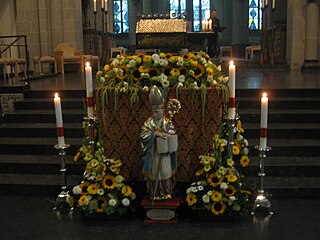 W
WSaint Altfrid was a leading figure in Germany in the ninth century. A Benedictine monk, he became Bishop of Hildesheim, and founded Essen Abbey. He was also a close royal adviser to the East Frankish King Louis the German.
 W
WAnnales Laurissenses minores or ALM is the Latin name of a medieval, historiographic text from the abbey at Lorsch near Worms in Germany. In many German texts, they are also called the Kleine Lorscher Frankenchronik, but in English may be referred to as the "Short chronicle of Lorsch" or "Lesser Annals of Lorsch".
 W
WThe Annales Xantenses or Annals of Xanten are a series of annals written, probably at Lorsch for the period 832 to 852 and at Cologne for the period until 873. The Lorsch author is probably Gerward, a royal chaplain, but the continuator is unknown. For that period (832–873) they present an independent source to augment the other Reichsannalen.
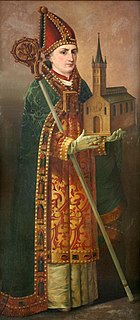 W
WAnsgar, also known as Anskar, Saint Ansgar, Saint Anschar or Oscar, was Archbishop of Hamburg-Bremen in the northern part of the Kingdom of the East Franks. Ansgar became known as the "Apostle of the North" because of his travels and the See of Hamburg received the missionary mandate to bring Christianity to Northern Europe.
 W
WArno, Arn or Aquila was bishop of Salzburg, and afterwards its first archbishop. He preserved his voluminous correspondence from the scholar Alcuin of York.
 W
WThe epithet "Bavarian Geographer" is the conventional name for the anonymous author of a short Latin medieval text containing a list of the tribes in Central-Eastern Europe, headed Descriptio civitatum et regionum ad septentrionalem plagam Danubii.
 W
WBenedict of Aniane, born Witiza and called the Second Benedict, was a Benedictine monk and monastic reformer, who left a large imprint on the religious practice of the Carolingian Empire. His feast day is February 12.
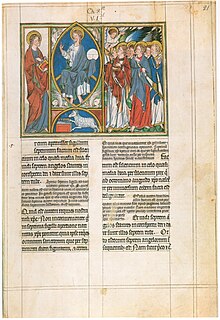 W
WBerengaudus (840–892) was a Benedictine monk, supposed author of Expositio super septem visiones libri Apocalypsis, a Latin commentary on the Book of Revelation. He has traditionally been assumed to be a monk of Ferrières Abbey, at the time of Lupus Servatus. The attribution has been questioned, but the Expositio was later much circulated in manuscript. It was printed in Patrologia Latina vol. XVII under Ambrose, following an attribution by Cuthbert Tunstall.
 W
WThe Book of Cerne is an early ninth-century Insular or Anglo-Saxon Latin personal prayer book with Old English components. It belongs to a group of four such early prayer books, the others being the Royal Prayerbook, the Harleian prayerbook, and the Book of Nunnaminster. It is now commonly believed to have been produced sometime between ca. 820 and 840 CE in the Southumbrian/Mercian region of England. The original book contains a collection of several different texts, including New Testament Gospel excerpts, a selection of prayers and hymns with a version of the Lorica of Laidcenn, an abbreviated or Breviate Psalter, and a text of the Harrowing of Hell liturgical drama, which were combined together to provide a source used for private devotion and contemplation. Based on stylistic and palaeographical features, the Book of Cerne has been included within the Canterbury or Tiberius group of manuscripts that were manufactured in southern England in the 8th and 9th centuries CE associated with the Mercian hegemony in Anglo-Saxon England. This Anglo-Saxon manuscript is considered to be the most sophisticated and elaborate of this group. The Book of Cerne exhibits various Irish/Celtic, Anglo-Saxon, Continental, and Mediterranean influences in its texts, ornamentation, and embellishment.
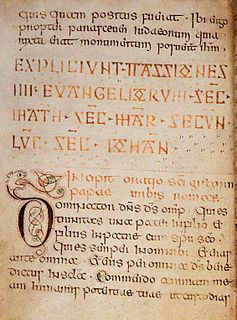 W
WThe Book of Nunnaminster is a 9th-century Anglo-Saxon prayerbook. It was written in the kingdom of Mercia, using an "insular" hand, related to Carolingian minuscule. It was probably later owned by Ealhswith, wife of Alfred the Great. It is related to, but of an earlier date than, the Book of Cerne, and also to the Royal Prayerbook and the Harleian prayerbook. Like Cerne it contains the Passion narratives of the four Gospels and a collection of non-liturgical prayers, many of which relate to the Passion. The Book of Nunnaminster shares some poems with the Book of Cerne. The Book of Nunnaminster includes some decorated initials.
 W
WClaudius of Turin was the Catholic bishop of Turin from 817 until his death. He was a courtier of Louis the Pious and was a writer during the Carolingian Renaissance. He is most noted for teaching iconoclasm, a radical idea at that time in Latin Church, and for some teachings that prefigured those of the Protestant Reformation. He was attacked as a heretic in written works by Saint Dungal and Jonas of Orléans.
 W
WThe Collectio canonum quadripartita is an early medieval canon law collection, written around the year 850 in the ecclesiastical province of Reims. It consists of four books. The Quadripartita is an episcopal manual of canon and penitential law. It was a popular source for knowledge of penitential and canon law in France, England and Italy in the ninth and tenth centuries, notably influencing Regino's enormously important Libri duo de synodalibus causis. Even well into the thirteenth century the Quadripartita was being copied by scribes and quoted by canonists who were compiling their own collections of canon law.
 W
WDhuoda was a Frankish writer, as well as Duchess consort of Septimania and Countess consort of Barcelona. She was the author of the Liber Manualis, a handbook written for her son.
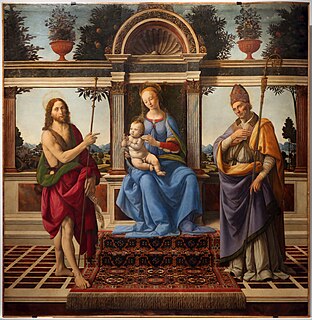 W
WSaint Donatus of Fiesole was an Irish teacher and poet, and Bishop of Fiesole, about 829–876.
 W
WThe Drogo Sacramentary is a Carolingian illuminated manuscript on vellum from c. 850 AD, one of the monuments of Carolingian book illumination. It is a sacramentary, a book containing all the prayers spoken by the officiating priest during the course of the year.
 W
WEbbo or Ebo was archbishop of Rheims from 816 until 835 and again from 840 to 841. He was born a German serf on the royal demesne of Charlemagne. He was educated at his court and became the librarian and councillor of Louis the Pious, king of Aquitaine, son of Charlemagne. When Louis became emperor, he appointed Ebbo to the see of Rheims, then vacant after the death of Wulfaire.
 W
WEinhard was a Frankish scholar and courtier. Einhard was a dedicated servant of Charlemagne and his son Louis the Pious; his main work is a biography of Charlemagne, the Vita Karoli Magni, "one of the most precious literary bequests of the early Middle Ages."
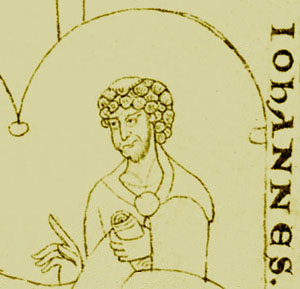 W
WJohn Scotus Eriugena or Johannes Scotus Erigena was an Irish theologian, neoplatonist philosopher, and poet. He succeeded Alcuin of York (735–804) as head of the Palace School at Aachen.
 W
WFerdomnach was an Irish illuminator who is responsible for the Book of Armagh.
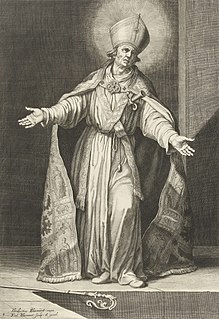 W
WFrederick I was Bishop of Utrecht between 815/816 and 834/838 AD, and is a saint of the Eastern Orthodox Church and Roman Catholic Church.
 W
WThe so-called Aachen Compilation of 809–812, also called the Handbook of 809 is a Carolingian astronomical compendium, compiled by a group of astronomers who gathered at the court of Charlemagne at Aachen in the year 809.
 W
WHilduin was Bishop of Paris, chaplain to Louis I, reforming Abbot of the Abbey of Saint-Denis and an author. He was one of the leading scholars and administrators of the Carolingian empire.
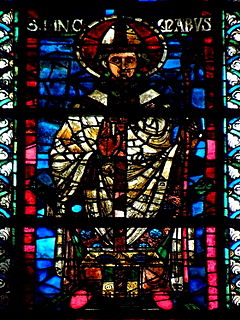 W
WHincmar, archbishop of Reims, was a Frankish jurist and theologian, as well as the friend, advisor and propagandist of Charles the Bald. He belonged to a noble family of northern Francia.
 W
WJohannes Hymonides, known as John the Deacon of Rome, was a deacon of the Roman Church. Few details are known of his life: after the death of St Nicholas I, he was briefly exiled from Rome at the behest of the emperor Louis II, but was recalled by Adrian II. Possessed of considerable learning, he was closely associated with Anastasius, Librarian of the Roman Church.
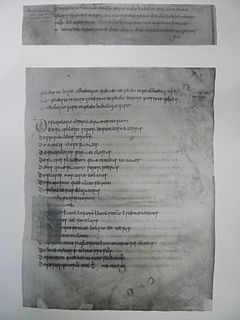 W
WThe Indiculus superstitionum et paganiarum is a Latin collection of capitularies identifying and condemning superstitious and pagan beliefs found in the north of Gaul and among the Saxons during the time of their subjugation and conversion by Charlemagne.
 W
WLeiden, Universiteitsbibliotheek, VLQ 79, also called the Leiden Aratea, is an illuminated copy of an astronomical treatise by Germanicus, based on the Phaenomena of Aratus. The manuscript was created in the region of Lorraine and has been dated to around 816. It was produced at the court of Louis the Pious, who ruled from 814–840. It is one of the four Carolingian codices that were produced in his court. There are many translations and copies of this text, so it is very well known throughout the Middle East and Europe.
 W
WLeidrad was the bishop of Lyon from 797 and its first archbishop from 804 until 814. He was a courtier of Charlemagne before he was a bishop. As bishop, he helped resolve the adoptionist controversy. He also began a programme of building and renovation in his diocese, turning Lyon into a centre of learning. Of his writings, two letters and a treatise on baptism survive.
 W
WThe Liber de apparitione Sancti Michaelis in Monte Gargano is a composite 9th century hagiographical text by an anonymous author containing the foundation myth of the Sanctuary of Monte Sant'Angelo, also known as Mont Gargano, on Mount Gargano, Italy, in northern Apulia. It contains record of the first known appearance of Saint Michael the Archangel in western Europe after the transmission of his cult from the Greek East.
 W
WNotker the Stammerer, also called Notker I, Notker the Poet or Notker of Saint Gall, was a musician, author, poet, and Benedictine monk at the Abbey of Saint Gall, now in Switzerland. He is commonly accepted to be the "Monk of Saint Gall" who wrote Gesta Karoli.
 W
WPlegmund was a medieval English Archbishop of Canterbury. He may have been a hermit before he became archbishop in 890. As archbishop, he reorganised the Diocese of Winchester, creating four new sees, and worked with other scholars in translating religious works. He was canonised after his death.
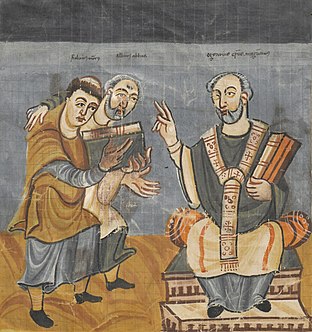 W
WRabanus Maurus Magnentius, also known as Hrabanus or Rhabanus, was a Frankish Benedictine monk, theologian, poet, encyclopedist and military writer who became archbishop of Mainz in East Francia. He was the author of the encyclopaedia De rerum naturis. He also wrote treatises on education and grammar and commentaries on the Bible. He was one of the most prominent teachers and writers of the Carolingian age, and was called "Praeceptor Germaniae," or "the teacher of Germany." In the most recent edition of the Roman Martyrology, his feast is given as 4 February and he is qualified as a Saint ('sanctus').
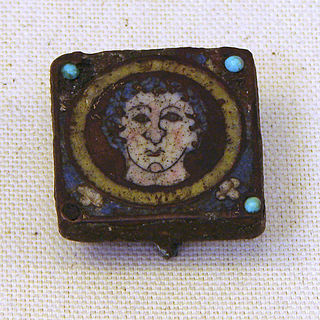 W
WThegan of Trier was a Frankish Roman Catholic prelate and the author of Gesta Hludowici imperatoris which is a principal source for the life of the Holy Roman Emperor Louis the Pious, the son and successor of Charlemagne.
 W
WTheodulf of Orléans was a writer, poet and the Bishop of Orléans during the reign of Charlemagne and Louis the Pious. He was a key member of the Carolingian Renaissance and an important figure during the many reforms of the church under Charlemagne, as well as almost certainly the author of the Libri Carolini, "much the fullest statement of the Western attitude to representational art that has been left to us by the Middle Ages". He is mainly remembered for this and the survival of the private oratory or chapel made for his villa at Germigny-des-Prés, with a mosaic probably from about 806. It was in Bible manuscripts produced under his influence that the Book of Baruch and the Letter of Jeremiah became part of the Western (Vulgate) Bible canon.
 W
WVita Hludovici or Vita Hludovici Imperatoris is an anonymous biography of Louis the Pious, Holy Roman Emperor and King of the Franks from AD 814 to 840.
 W
WWandelbert was a Benedictine monk and theological writer. Little is known of his personal history. He was apparently a native of Francia, and in 839 he was already a monk at the Abbey of Prüm, where he died. About this date Abbot Markward commissioned him to rewrite the old Life of St. Goar and to supplement it by an account of the miracles worked by the saint. The life Wandelbert wrote is not without historical value.
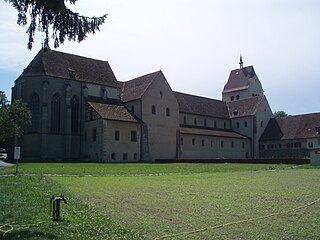 W
WWetti of Reichenau was a Benedictine monk, scholar and educator at the monastery at Reichenau in modern-day Germany. He was one of the leading educators of his time, and an influential scholar among monks and laity throughout not only the Carolingian empire but also the Western European monastic community. His best known surviving work is his biography of Saint Gallus, the founder of Reichenau's sister monastery, St Gall.